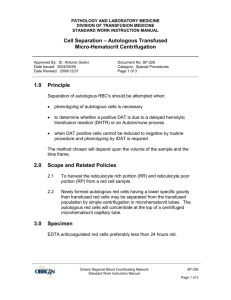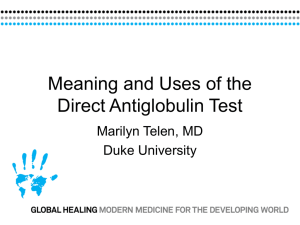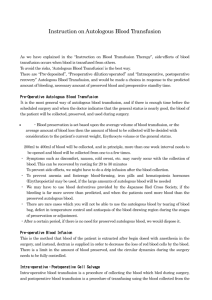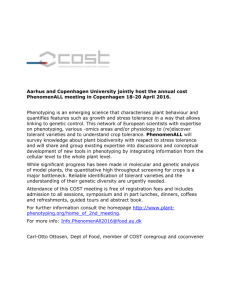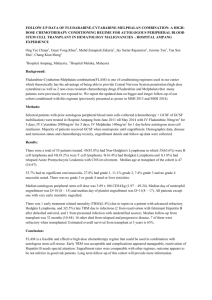SP.027 - Cell Separation Wintrobe
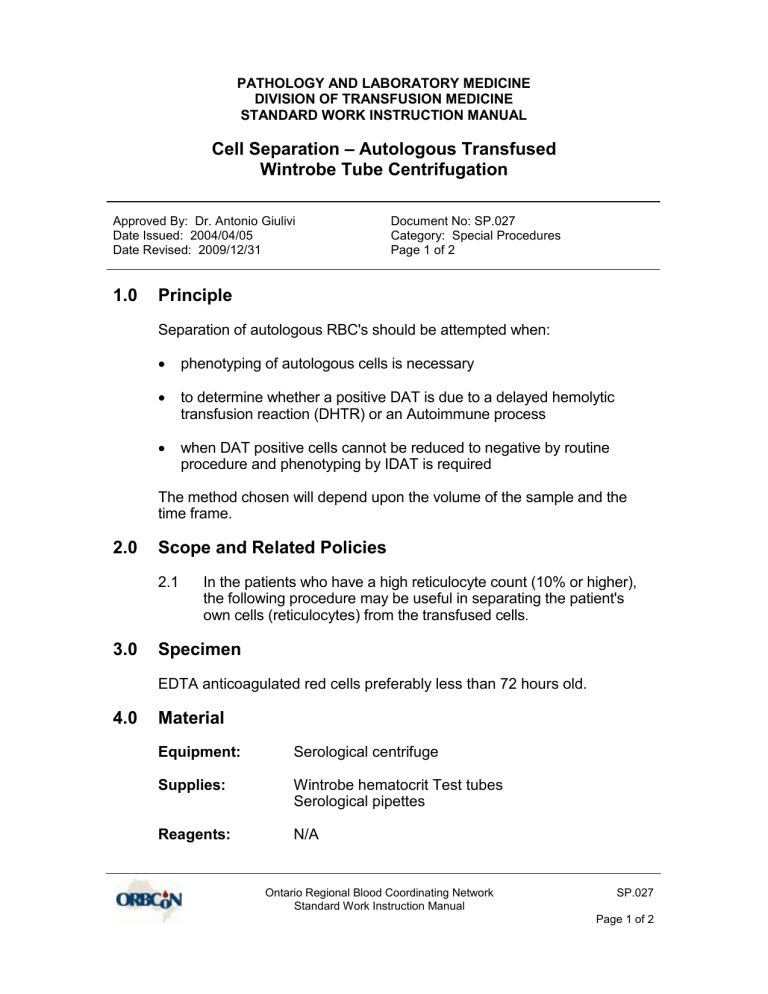
PATHOLOGY AND LABORATORY MEDICINE
DIVISION OF TRANSFUSION MEDICINE
STANDARD WORK INSTRUCTION MANUAL
Cell Separation – Autologous Transfused
Wintrobe Tube Centrifugation
Approved By: Dr. Antonio Giulivi
Date Issued: 2004/04/05
Date Revised: 2009/12/31
1.0 Principle
Document No: SP.027
Category: Special Procedures
Page 1 of 2
Separation of autologous RBC's should be attempted when:
phenotyping of autologous cells is necessary
to determine whether a positive DAT is due to a delayed hemolytic transfusion reaction (DHTR) or an Autoimmune process
when DAT positive cells cannot be reduced to negative by routine procedure and phenotyping by IDAT is required
The method chosen will depend upon the volume of the sample and the time frame.
2.0 Scope and Related Policies
2.1 In the patients who have a high reticulocyte count (10% or higher), the following procedure may be useful in separating the patient's own cells (reticulocytes) from the transfused cells .
3.0 Specimen
EDTA anticoagulated red cells preferably less than 72 hours old.
4.0 Material
Equipment:
Supplies:
Reagents:
Serological centrifuge
Wintrobe hematocrit Test tubes
Serological pipettes
N/A
Ontario Regional Blood Coordinating Network
Standard Work Instruction Manual
SP.027
Page 1 of 2
Cell Separation – Autologous Transfused
Wintrobe Tube Centrifugation
5.0 Quality Control – N/A
6.0 Procedure
6.1 Fill several Wintrobe hematocrit tubes with whole blood from EDTA blood sample.
6.2 Centrifuge at 1500 g for one hour.
6.3 Remove plasma and buffy coat.
6.4 Gently remove the top tenth of the red cell column; this should contain predominantly reticulocytes. The reactions of these cells in the direct antiglobulin test and in blood grouping tests can be compared with the reactions obtained with cells taken from the bottom layer of the red cell column. See NRT.009 Antigen Typing-
Direct and Indirect Agglutination, RT.004 Direct Antiglobulin Test.
6.5 See Procedural Notes 8.1 for examples of results using separated cells.
7.0 Reporting – N/A
8.0 Procedural Notes
8.1 Example of Results using separated cells:
Reticulocytes DAT
Whole Blood
Top Layer
Approx. 10%
Approx. 70%
++
O
Bottom Layer 1% ++
9.0 References
9.1 B.E.E. Croucher, A Seminar On Laboratory Management of
Hemolysis p.157, AABB 1979 .
Ontario Regional Blood Coordinating Network
Standard Work Instruction Manual
SP.027
Page 2 of 2
